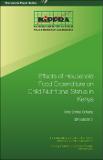| dc.description.abstract | This study examines the effect of household food expenditure on child nutritional
status in Kenya for children between 6 and 60 months. Household food budget
share is used instead of household food expenditure to capture poverty and
income aspects of the households, an issue that cannot be well articulated by
the former. Using the Kenya Integrated Household Budget Survey (KIHBS)
2005/2006, this study uses the Instrumental Variable (IV) probit approach
to examine the underlying relationships. Household food budget share and
participation in child growth clinic is found to be endogenous.
After correcting for endogeneity, the results reveal that the higher the household
food budget share, the higher the chances of a child being malnourished.
As a measure of poverty, it shows that malnutrition affects the poor who
spend a greater share of their budget on food. The results also show that
malnutrition increases with age. Exclusive breast-feeding reduces chances
of child malnutrition, and participation in child growth monitoring clinic
reduces malnutrition. Secondary level of education for mothers helps to reduce
malnutrition, and single motherhood, either by choice or circumstances (death,
divorce or separation), increases chances of child malnutrition.
In terms of policy, the study recommends an integrated strategy that improves
child participation in growth monitoring clinic, which should also incorporate
lessons on child nutrition. There is need to refocus government efforts in ensuring
a minimum of secondary education for girls. Optimal exclusive breast-feeding
can be achieved through facilitation of community-based promotion efforts
supported by government procedures and government subsidy of food prices
to bring down the food budget share. This will not only make food available for
households, but also improve household welfare in terms of schooling and health
care. | en |

